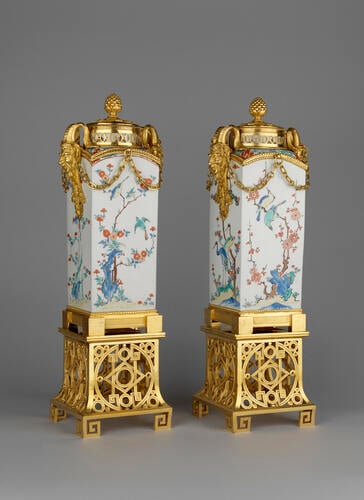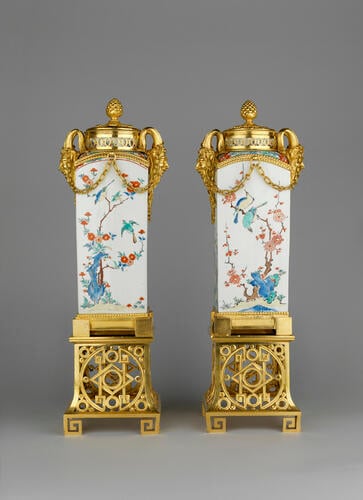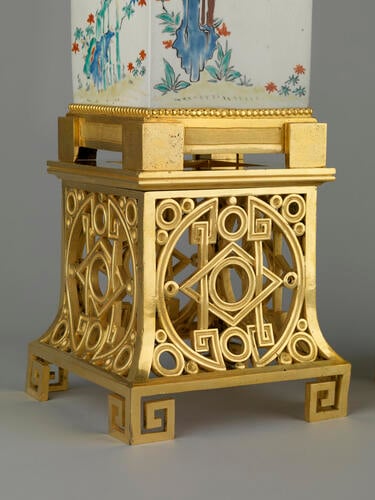Pair of square jars and covers on stands porcelain; 1670-90, mounts: 3rd quarter 18th, early 19th century
Porcelain painted in Kakiemon-style with overglaze enamels, gilt bronze mounts | 51.6 x 18.0 x 18.0 cm (largest part) | RCIN 2337

Arita, Hizen province [Japan]
Pair of square jars and covers on stands porcelain; 1670-90, mounts: 3rd quarter 18th, early 19th century

Arita, Hizen province [Japan]
Pair of square jars and covers on stands porcelain; 1670-90, mounts: 3rd quarter 18th, early 19th century

Arita, Hizen province [Japan]
Pair of square jars and covers on stands porcelain; 1670-90, mounts: 3rd quarter 18th, early 19th century




-
A pair of mounted Japanese Kakiemon jars. Tall, straight-sided, square bottles, with rounded shoulder and short round neck; the almost flat cover with a button knob and painted with the same designs. Each mounted with a berried finial emerging from a spreading acanthus leaf, with a ribbed and plain moulded rim above a neck pierced with ovals; each side with horned satyr masks above trailing ivy; the shoulder mount with two rows of pearls and draped with chains from the satyr horns; the foot set in a pearled (or beaded) border and a burnished and pounced panelled plinth, with square, burnished corner feet. The vases mounted on French and English gilt-bronze mounts. They stand on added high, square pedestals of intricate pseudo-oriental design, the pierced stand of spreading square form, with a pierced roundel enclosing a lozenge enclosing a circle, the spandrels with three circles of two sizes, on Greek key feet.
At Carlton House, they appear in Charles Wild's watercolour of the Rose Satin Drawing Room on a cabinet on the left wall (Pyne 1819, II, pl. opp. p. 30). One of a pair of Kakiemon-style hexagonal vases in the Collection (RCIN 2336.1–2) from the Chelsea factory, with gilt-bronze bases of openwork design and perhaps French workmanship, may have provided a model for Vulliamy. Perhaps surprisingly, neither was included in the earlier scheme for the Chinese Drawing Room – they do not appear in the Coutts Inventory (Coutts Inventory of Carlton House 1793, pp. 59–60). On 9 December 1812, Vulliamy delivered ‘a Pair of metal Pedestals in the Chinese Style, to raise a pair of Square Japan Bottles mounted in Ormoulu [sic] … £47.5.–’ (National Archives C104/58(II), Ledger no. 34, p. 212). First recorded in Vulliamy’s invoice to the Prince of Wales, 22 December 1806, for removing the mounts for cleaning and regilding. At the same time, the vases were drilled for screws. The total cost was £15 (National Archives C104/58(II), Ledger no. 32, p. 77). In January 1820, C. Brandt submitted an invoice for ‘Restoring the Ornaments of 2 square China Jars with Goat Heads on chains etc.-- £2.2.–’ (National Archives LC 11/28). A pair of identical square jars, with simpler four-legged French mounts, is in the Collection, RCIN 39238.1-2.Japanese porcelains of the late seventeenth century painted in this harmonious and colourful palette are generously represented in the Royal Collection, especially at Hampton Court Palace (see RCINs 1094.1-2, 1178.1-2, 1050.1-2, 1047.1-2, 1110.1-2). They were perhaps the most admired of all imported wares of their time, and in consequence were extensively copied, first at Meissen in Germany, and thereafter at many other early porcelain factories in Europe.
Text adapted from Chinese and Japanese Works of Art in the Collection of Her Majesty The Queen: Volume II and Japan: Courts and Culture (2020)Provenance
George IV, by 1806. Jutsham Recs I.9: ‘Mr Vulliamy. A Pair of Square Japan China Jars mounted with Satyr’s heads. June 11th 1807’. Recorded in the Banqueting Room Gallery at the Royal Pavilion, Brighton, as ‘A pair of square Canister shaped China Jars & Covers enamelled in Birds, Trees, and Flowers, mounted in ormolu Satyr mash [mask] and vine leaf handles, chains, pierced borders and fluted knobs – panelled ormolu bases, & corner blocks on square open work stands, with feet, twenty & a half inches [52.1 cm], glass shades and stands’ (1829B, p. 7). In 1847, they were sent to Buckingham Palace (1829A, p. 20), and in March 1914, noted there in the Centre Room.
Exhibited in Japan und Europa, 1543–1929, Martin-Gropius-Bau, Berlin, 1993. -
Creator(s)
(place of production)(metalworker)(nationality)Acquirer(s)
-
Medium and techniques
Porcelain painted in Kakiemon-style with overglaze enamels, gilt bronze mounts
Measurements
51.6 x 18.0 x 18.0 cm (largest part)
Other number(s)
Place of Production
Arita [Saga, Japan]







